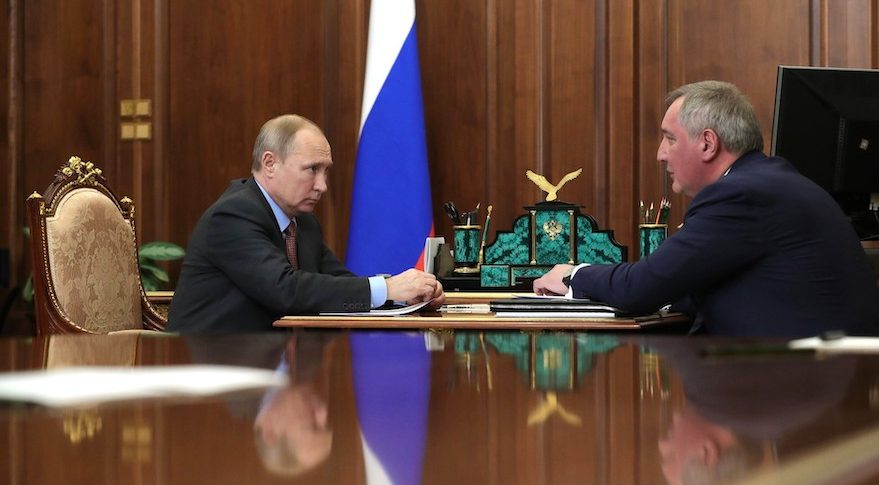Roscosmos Chief Dmitry Rogozin Teases New Russian Super-Heavy Rocket Yenisei

MOSCOW — With the collapse of a major U.S.-Russia arms treaty last week, much attention is being paid to new Russian rockets. In Moscow, the Kremlin has ordered its generals to begin crash development of an array of intermediate-range missiles. But while all of this was going on, President Vladimir Putin has also been reviewing other ambitious rocket programs.
On Feb. 4, Roscosmos Director Dmitry Rogozin went to the Kremlin to sit down with Putin for a check-in on the state of the Russian space program. Much of the meeting focused on Roscosmos financials, which are bleak. But toward the end of the publicized portion of their discussion, Rogozin provided an update on three key rocket projects.
The first was Soyuz-5, which is being promised as the future flagbearer of the Russian crewed space program. Everything is in position to move forward with the project, he said, and promised a first flight by 2022. That flight, he added, will feature Russia's long-promised next-generation Federation spacecraft, a replacement to the solid old Soyuz capsule. [Top 10 Soviet and Russian Space Missions]
Rogozin also reported that Russia's other major rocket program, the Angara family of boosters, will see another test flight this year — again demonstrating the heavy A5 variant with four strap on boosters. But of greater interest was a super-heavy rocket for missions to the moon, one that will fuse Soyuz-5 with Angara to save countless rubles in development costs.
"The general schedule has been endorsed for building the ground-based space infrastructure," Rogozin told Putin of the moon rocket, "and the exterior design of this rocket has practically been chosen."
Not much else was said of the rocket during the Kremlin meeting, at least according to the public transcript. Perhaps Rogozin did not want to get too far ahead of himself in Putin's presence. After all, as noted later this week by one of Rogozin's subordinates, the government is not set to award any additional funding for a moon program before April.
But on Twitter just hours before his meeting with Putin, Rogozin posted a photo of a large binder that he claimed was the in-depth development schedule for the super-heavy rocket. 2028 is the target date, he said, and even gave it a name: Yenisei. The primary contractors for the project will be Energia and Progress, and Khrunichev — which will be responsible for the third stage.
Get the Space.com Newsletter
Breaking space news, the latest updates on rocket launches, skywatching events and more!
The list of contractors corresponds with what little we know of the proposed Russian lunar rocket. Over the past several months, reports have surfaced in the Russian press about Roscosmos design studies and decisions on architecture for missions to the moon. Depending on the day, these are to be either entirely Russian efforts, or cooperative efforts with NASA.
In December, Roscosmos reported as part of an early draft proposal that "under tight budgetary constraints, all parts of the super-heavy rocket should have the ability to fly independently and go into serial production [independently]," TASS quoted a Roscosmos statement as saying at the time. In practice, this means a fusion of Soyuz-5 and Angara.
The first stage of the Yenisei rocket, according to these reports, will be comprised of clustered Soyuz-5 boosters — or some modification thereof — while the third stage will be taken from Khrunichev's Angara rocket line. Energia is the developer of Soyuz-5, and Progress is set to be the manufacturer. The two work together on the current Soyuz family of rockets.
According to the proposal cited by TASS in December, the Yenisei booster will be designed to throw 70 tons into low-Earth orbit and will lift off from Russia's new Vostochny Cosmodrome in the Far East. First flights are envisioned by 2028, but given the apparent reliance on Soyuz-5 development and the future of Angara, this date is likely overly-optimistic.
Money is also the salient issue. There should be little doubt Russian engineers can design a super-heavy rocket. But Roscosmos is already facing tough budget constraints and, beyond the political utility of keeping Russia in space and keeping the missile industry healthy, it is not clear whether the Kremlin truly values its space program.
The price tag of such a project will be steep. According to Russian reports, Roscosmos has estimated the cost of developing Yenisei and building infrastructure for it at 1.5 trillion rubles ($22.7 billion). These do not take into account any of the other facets of a potential lunar expedition, as noted by Yury Koptev, head of Roscosmos scientific and technical council.
"When the theme of the moon arises, everything is reduced to the issue of creating a super-heavy rocket, and this is simply not the case," Koptev said Feb. 6. "We are talking about complex flights to circumlunar orbit, to the lunar surface, conducting various experiments there, combining manned flights with probes."
These are the issues currently being weighed by the Russian government, Koptev said. And by April, they should weigh in. And if past actions by the government on Roscosmos funding are any indication, proponents of a Russian lunar program shouldn't get their hopes up.
This story was provided by SpaceNews, dedicated to covering all aspects of the space industry.
Join our Space Forums to keep talking space on the latest missions, night sky and more! And if you have a news tip, correction or comment, let us know at: community@space.com.











